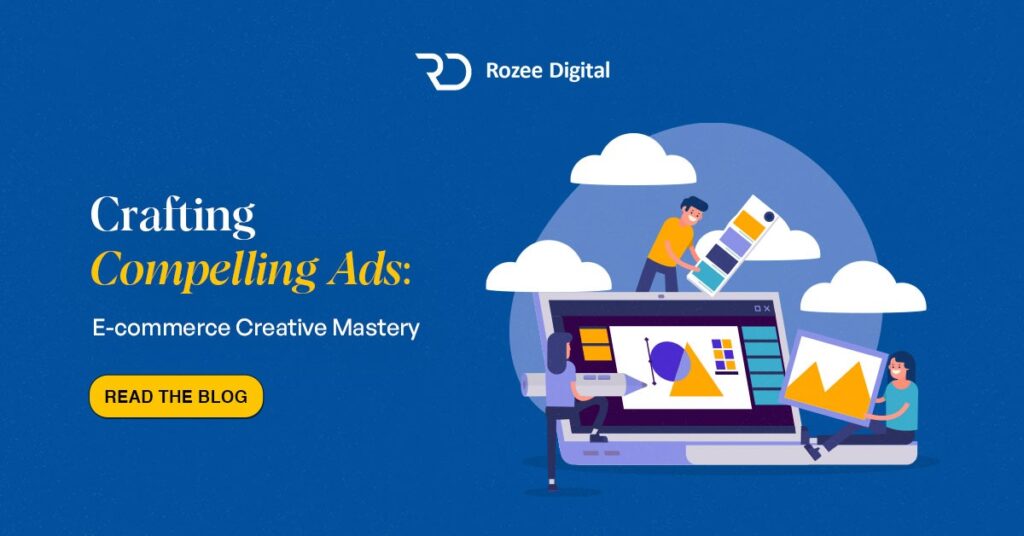Today, the ability to craft compelling ads is more critical than ever. With countless brands vying for consumers’ attention, your ads must stand out, capture interest, and drive action. So, the ability to influence, persuade, and attract customers hinges on the art of crafting product ad creatives that resonate and captivate. Whether you’re navigating the world of e-commerce or maximizing your advertising impact, creating compelling ad creatives is essential for success.
This blog post will delve into the essential elements of e-commerce ad creative mastery, offering practical tips and strategies to help you create ads that not only attract but also convert.
What are Creatives in Advertising?
Before diving into the how-to, let’s clarify what are creatives in advertising. In essence, advertising creatives are the visual and textual components of an ad that aim to convey a specific message to the target audience. These elements include images, videos, headlines, and copy that work together to capture attention and encourage action. They represent the first impression the audience forms of the product or service being advertised in a marketing campaign. It’s important to distinguish between “creatives” and “ads” because they play different roles in marketing:
What are Creatives: These are the individual components, such as images, videos, text, and audio, that make up the visual and auditory aspects of an advertisement. Creatives are the building blocks of an ad and are responsible for capturing the audience’s attention.
What are Ads: In contrast, “ads” encompass the broader context in which creatives exist. They provide the structure and purpose for creatives to function effectively. Ads include elements such as the brand, the message, targeting, and placement. Essentially, ads are the overall message or campaign being promoted.
It’s crucial to recognize that “creatives” and “ads” are closely intertwined and collaborate to craft effective advertising. The synergy between compelling creatives and well-crafted ads has the potential to shape a potent advertising campaign that deeply connects with the target audience and yields remarkable results.
In simpler terms, creatives and ads work hand in hand. When you combine captivating creatives with thoughtfully designed advertisements, you create a robust advertising campaign that truly resonates with your intended audience and delivers impressive outcomes.
Why Ad Creatives are Key in Your Marketing Campaigns
Effective ad creatives are the backbone of successful marketing campaigns. They:
- Capture Attention: In a sea of digital content, eye-catching creatives help your ads stand out.
- Communicate Value: They clearly convey the benefits and unique selling points of your products.
- Drive Engagement: Well-crafted creatives encourage clicks, shares, and ultimately, conversions.
- Enhance Brand Recognition: Consistent and on-brand creatives reinforce your brand identity, making it more memorable to consumers.
The Impact of Effective Ad Creatives is undeniable on Brand Visibility and Consumer Engagement
- Brand Visibility: Creatives for ads are essential to ensure that a brand stands out in a saturated market. They serve as the gateway to brand recognition.
- Consumer Engagement: Ad creatives that successfully capture the audience’s attention attract the audience and drive interaction. This can translate into more clicks and ultimately lead to increased sales and revenue.
In the era of digital advertising, creative elements become even more crucial, as they must be attractive enough to stand out in a world where competition for attention is intense. Optimizing creative elements, such as images, text, and animations, is essential to adapt to various platforms and formats, including social media, display ads, and video, to ensure maximum engagement.
The combination of influential ad creatives and well-crafted advertisements forms the foundation of a powerful advertising campaign that resonates with the target audience and generates remarkable results.
Different Types of Ad Creatives
Advertisers today have access to a wide range of ad creatives. The format you choose will depend on various factors such as your advertising objectives, target audience, and budget. Here are some of the most common types:
- Static Creatives: These digital marketing creative ads remain unchanged over time, displaying the same content to all users.
- Banners: The most common digital ads, banners come in various sizes, from small banners to large full-screen ads.
- Rich Media Ads: These are interactive banners that include elements such as video, audio, or animations.
- Native Ads: These ads blend seamlessly with the content and style of the platform they appear on, making them look like part of the content.
- Dynamic Creatives: Automatically generated ads using pre-defined data and rules. These allow advertisers to show more relevant and personalized ads, leading to better campaign results.
- Interactive Creatives: Ads that allow user interaction, such as games, quizzes, or polls within the ad.
- Video Creatives: Video ads that can be short or long-form, including linear and non-linear video.
- In-Stream Video Ads: These ads play before, during, or after online videos.
- Out-Stream Video Ads: These ads play on websites and applications that are not primarily video platforms.
- Audio Creatives: Ads that are broadcast on radio, podcasts, or audio streaming services.
- Augmented Reality (AR) and Virtual Reality (VR) Creatives: These use AR and VR technologies to create immersive experiences, allowing users to interact with the ad in a virtual environment.
- Influencer Creatives: Collaborations with influencers to create promotional content that leverages their audience and credibility.
How to Maintain Brand Consistency in Your Campaigns with On-Brand Creatives
On-brand creatives are advertising materials, including visuals, messaging, and design elements, that adhere to a brand’s established guidelines and identity. They are essential for maintaining consistency and ensuring that the brand’s image and values remain intact across all marketing materials.
The importance of using on-brand creatives in your campaigns cannot be overstated. Here’s why they are crucial:
Consistent Brand Identity: On-brand creatives help establish and maintain a consistent brand identity. They ensure that every piece of marketing material, from advertisements to social media posts, carries the same look, feel, and messaging, strengthening brand recognition.
Trust and Reliability: Consistency builds trust and reliability with your audience. When consumers encounter a brand with consistent visuals and messaging, they are more likely to trust the brand and become loyal customers.
Efficient Marketing: On-brand creatives save time and resources in the long run. With established guidelines, you can create marketing materials more efficiently and with fewer revisions.
Professionalism: On-brand creatives convey professionalism. They show that your brand pays attention to detail and values a cohesive image, which can attract a more discerning customer base.
Creatives in Marketing: Enhancing Campaign Impact
Practical tips and strategies
Creative marketing involves the strategic use of visual and auditory elements to enhance the impact of advertising campaigns. Here are the practical tips and strategies to help you create compelling ads that not only attract but also convert
1. Understand Your Audience
The foundation of any successful ad campaign is a deep understanding of your target audience. Knowing their preferences, pain points, and behavior patterns allows you to tailor your message to resonate with them.
Steps to Understand Your Audience:
- Market Research: Utilize tools like surveys, social media insights, and analytics to gather data on your audience.
- Create Buyer Personas: Develop detailed profiles of your ideal customers, including demographics, interests, and buying behavior.
- Analyze Competitors: Look at what works for your competitors and identify gaps or opportunities to differentiate your brand.
2. Craft a Captivating Headline
Your headline is the first thing potential customers will see, so it needs to grab their attention immediately. A strong headline is clear, concise, and speaks directly to your audience’s needs or desires.
Tips for a Great Headline:
- Be Specific: Highlight a unique benefit or feature of your product.
- Use Numbers: Statistics or lists can make your headline more compelling (e.g., “5 Ways to Boost Your Sales”).
- Create Urgency: Phrases like “Limited Time Offer” or “Act Now” can encourage immediate action.
3. Leverage High-Quality Visuals
In the digital world, visuals are crucial. High-quality images and videos are crucial for producing better ad creatives that can significantly enhance your ad’s effectiveness by making it more appealing and memorable.
Best Practices for Visuals:
- Use Professional Photography: Ensure your product images are high-resolution and well-lit.
- Incorporate Videos: Videos can demonstrate your product in action, providing a more comprehensive understanding.
- Consistency: Maintain a consistent visual style across all your ads to strengthen brand recognition.
4. Write Persuasive Copy
Your ad copy should complement your visuals and headline, providing further information and compelling the viewer to take action. It should be clear, concise, and customer-centric.
Elements of Persuasive Copy:
- Highlight Benefits: Focus on what the customer will gain from your product.
- Use Social Proof: Testimonials, reviews, or user-generated content can build credibility.
- Include a Strong CTA: A clear call-to-action (CTA) directs the customer on what to do next, such as “Shop Now,” “Learn More,” or “Sign Up.”
5. Optimize for Mobile
With a significant portion of e-commerce traffic coming from mobile devices, ensuring your ads are mobile-friendly is essential for marketing of creatives. This means responsive design, fast loading times, and easy navigation.
Mobile Optimization Tips:
- Test on Multiple Devices: Ensure your ad looks good and functions well on various screen sizes.
- Simplify Navigation: Make it easy for users to find what they need and complete the desired action.
- Speed Matters: Optimize images and videos to reduce loading times.
6. Test and Iterate
Creating compelling ads is an ongoing process. Regularly testing different elements of your ads and making data-driven adjustments can help you continually improve their effectiveness.
Testing Strategies:
- A/B Testing: Compare different versions of your ad to see which performs better.
- Monitor Metrics: Track key performance indicators (KPIs) such as click-through rates (CTR), conversion rates, and return on ad spend (ROAS).
- Gather Feedback: Solicit feedback from your audience to understand what resonates with them.
The Main Challenges in Managing Ad Creatives
Effective management of ad creatives is crucial for successful marketing campaigns, but it comes with its own set of challenges. Here are the main challenges marketers often encounter:
Version Control
Ensuring that the most up-to-date and approved creative assets are used in campaigns can be difficult. Without a centralized system, different team members may work with outdated materials, leading to inconsistencies and mistakes.
Collaboration
Coordinating efforts among various team members, including designers, copywriters, and marketing managers, can be complex. Effective collaboration is essential for producing cohesive ad creatives.
Maintaining Brand Guidelines
Adhering to brand guidelines across all marketing materials can be a struggle for many businesses. Consistency is key, but ensuring that all creatives align with the brand’s identity and messaging can be challenging.
Adaptation to Multiple Platforms
Ad creatives must often be customized for various platforms and formats, including social media, display ads, and video. Adapting creatives to suit these diverse environments while maintaining consistency can be daunting.
Deadline Pressures
Meeting tight deadlines for ad campaigns is a constant challenge. Effective management of creatives requires efficient workflows to ensure that deadlines are met without compromising quality.
A/B Testing and Performance Tracking
Analyzing the performance of ad creatives, conducting A/B tests, and making data-driven decisions can be time-consuming. Marketers must be able to track the success of different creatives to optimize their campaigns.
Resource Management
Efficiently managing creative resources, such as images, videos, and design assets, can be a significant challenge. Disorganized resources can lead to inefficiency and difficulties in locating necessary materials.
Conclusion
Mastering the art of crafting compelling ad creatives in e-commerce requires a blend of creativity, strategic thinking, and continuous optimization. By understanding your audience, creating captivating headlines and visuals, writing persuasive copy, optimizing for mobile, and regularly testing your ads, you can significantly enhance your ad performance and drive greater success for your e-commerce business.
FAQS
1. What are creatives in advertising?
Creatives in advertising refer to the individual components, such as images, videos, text, and audio, that make up the visual and auditory aspects of an advertisement. These elements are designed to capture the audience’s attention and convey the intended message effectively.
2. What is the difference between creatives and ads?
Creatives are the individual components (images, videos, text, audio) that make up the visual and auditory aspects of an ad. Ads encompass the broader context, including the brand, message, targeting, and placement. Creatives are the building blocks, while ads are the overall message or campaign.
3. Why is it important to adapt ad creatives for different platforms?
Different platforms have unique formats, audiences, and engagement styles. Adapting creatives for each platform ensures maximum relevance and effectiveness, enhancing the overall impact of your marketing campaigns.
4. How can I ensure brand consistency in my ad creatives?
To ensure brand consistency:
- Develop and adhere to brand guidelines.
- Use templates for various ad formats.
- Conduct regular audits to check alignment with brand identity.
- Maintain a cohesive look and feel across all marketing materials.
5. What is the impact of effective ad creatives on brand visibility?
Effective ad creatives significantly improve brand visibility by making the brand stand out in a crowded market. They create memorable impressions, increase recognition, and foster a stronger connection with the audience.
6. How can I manage resources efficiently when creating ad creatives?
Efficient resource management involves organizing creative assets, using project management tools, and setting clear guidelines and workflows. This helps streamline the creative process, reduce inefficiencies, and ensure timely delivery of high-quality ad creatives.





